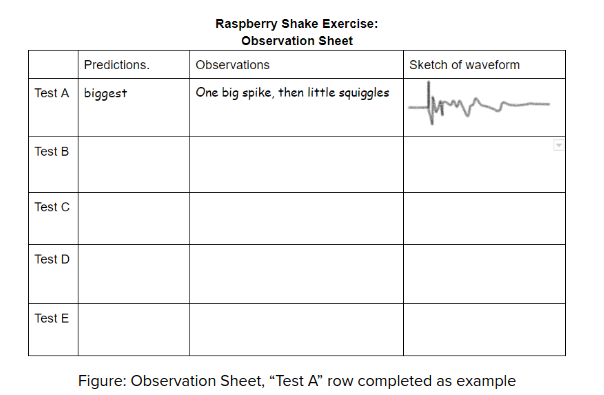Exercise: Wave Transfer Experiment!
Explore how energy is conducted through different types of matter and materials
- ~45+ minutes
- Ages 7+
- Entire class (students can complete worksheet in pairs)
- Extra materials required
Summary:
Students will understand how different mediums are better at transferring energy than others, through this experiment with the Raspberry Shake, by observing how waveforms change depending on the material that the sensor sits upon. Scientists call this transfer of energy waves wave propagation. Concepts explored in this experiment can be connected to the real-world application of building and engineering in earthquake-prone areas.
Pre-Class Preparation:
- Print the student worksheet (you can also decide to have the students copy the worksheet in a notebook
- Ensure that there is a functioning system (a separate computer, most likely) in place for the Raspberry Shake to stream live, real-time data for your classroom to view during this activity. You can find tips and instructions for that here.
- Clear a space in the front of the class on the floor for the sensor. It is important that the students can see what they are jumping at!
- Important: Make sure that your Raspberry Shake is in a position where it can be easily manipulated and placed on top of different objects. Including text books, a pillow, a small table, etc. The best way to do this is to ensure the Raspberry Shake has a long Ethernet connection and a long extension cord that allows it to be easily moved without disconnecting the device.
Materials:
- Raspberry Shake
- Computer and monitor for displaying RS data
- Small table/chair
- A pillow, a cushion, or foam
- Text books
- Plastic bag filled with water (very securely sealed!)
- Plastic bag filled with air
** For the bags, we recommend strong, plastic Zip-Lock type bags. BE CAREFUL!! Extra precaution is advised. Electronics and water are not the best of friends, so this is at your own risk.
Procedure:
In this activity, students will investigate how different mediums transfer energy. When someone jumps, the energy is released from the ground and transfers through the floor, and is recorded by the Raspberry Shake seismograph. What happens to the energy as it goes through different substances and materials? In this activity, students will explore that question.
Step 1 — Introduction and planning:
The Raspberry Shake seismograph is extremely portable, and because of its small size can be easily moved around, placed on top of different materials, and be recording data the whole time! Because the sensitive geophone on the Shake detects any motion/energy that passes under it, it can be used to investigate how energy waves get stronger or weaker according to the substance they are passing through. That is what this experiment explores! Students become scientists by making predictions, observations, and conclusions as the class conducts the experiment.
- Decide on a repeatable way in which your students will create ground motion. This can be a jump that is executed the same way, or a textbook dropped from a set height. Always the same distance away from the sensor.
- Introduce the students to the “Observation Sheet”, pictured below. (These can be completed in pairs)
- Encourage students to make observations like “one, tall spike” or “many, little waves”.

Step 2 — Get Shaking!
Gather the students near the monitor to watch the graph closely. When energy release (jump, book drop, etc.) occurs on the floor near the Shake releasing ground motion, it may take a few seconds for the data to register on the monitor. Remember, take notes of the observations and try to sketch the form of the graph in the space provided. Then, allow some time for the graph to reset after each test before proceeding to next test and then repeat this process for tests B through E.
- Test A: Control
- Raspberry Shake is placed on the floor
- Test B: Elevated (Sensor on table or chair)
- Sensor is placed on a chair or desk
- Test C: Cushioned
- Sensor is placed on a cushion or pillow
- Test D: Liquid
- Sensor is placed on a plastic bag full of water
- Test E: Air
- Sensor is placed on a plastic bag full of air
After the final test is complete and students have filled out their observations, proceed to Conclusions and Reflections.
Conclusions and Reflections:
Start a conversation with the students:
- What did we learn?
- Why is what we just learned important?
- What real-world applications could benefit from having this kind of knowledge?
Reinforce the real-world connection to engineering. Understanding how different materials transfer energy can be very important to architects and civil engineers when they construct buildings or plan developments. It is always helpful to understand how the world around us works.
